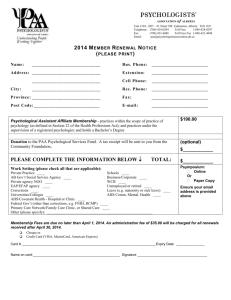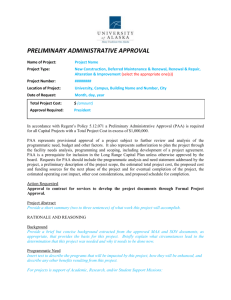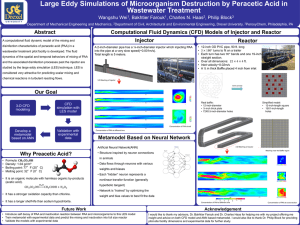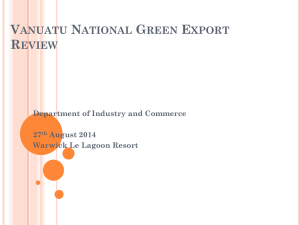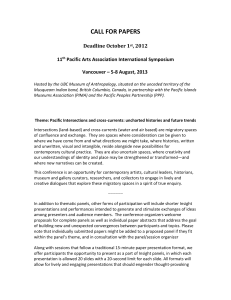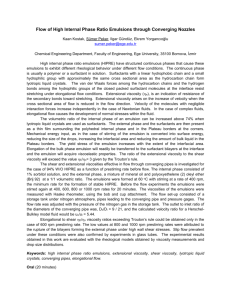Korea-Australia Rheology Journal Vol. 20, No. 3, September 2008 pp. 109-116
advertisement
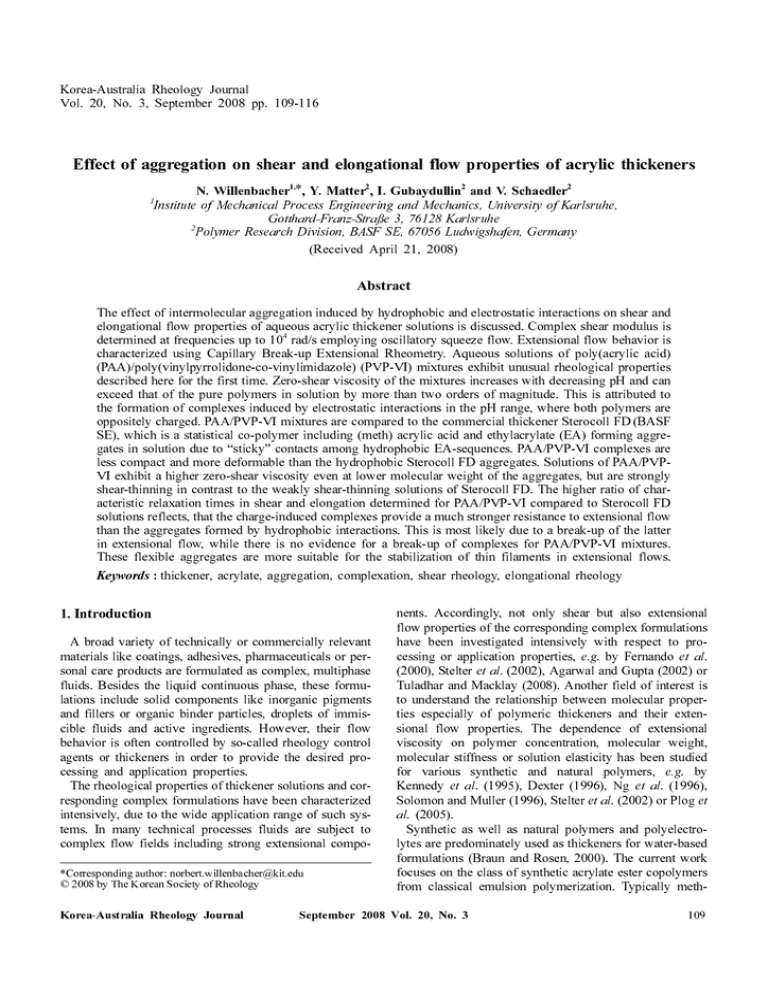
Korea-Australia Rheology Journal Vol. 20, No. 3, September 2008 pp. 109-116 Effect of aggregation on shear and elongational flow properties of acrylic thickeners N. Willenbacher *, Y. Matter , I. Gubaydullin and V. Schaedler 1, 2 2 2 Institute of Mechanical Process Engineering and Mechanics, University of Karlsruhe, Gotthard-Franz-Straße 3, 76128 Karlsruhe 2 Polymer Research Division, BASF SE, 67056 Ludwigshafen, Germany 1 (Received April 21, 2008) Abstract The effect of intermolecular aggregation induced by hydrophobic and electrostatic interactions on shear and elongational flow properties of aqueous acrylic thickener solutions is discussed. Complex shear modulus is determined at frequencies up to 10 rad/s employing oscillatory squeeze flow. Extensional flow behavior is characterized using Capillary Break-up Extensional Rheometry. Aqueous solutions of poly(acrylic acid) (PAA)/poly(vinylpyrrolidone-co-vinylimidazole) (PVP-VI) mixtures exhibit unusual rheological properties described here for the first time. Zero-shear viscosity of the mixtures increases with decreasing pH and can exceed that of the pure polymers in solution by more than two orders of magnitude. This is attributed to the formation of complexes induced by electrostatic interactions in the pH range, where both polymers are oppositely charged. PAA/PVP-VI mixtures are compared to the commercial thickener Sterocoll FD (BASF SE), which is a statistical co-polymer including (meth) acrylic acid and ethylacrylate (EA) forming aggregates in solution due to “sticky” contacts among hydrophobic EA-sequences. PAA/PVP-VI complexes are less compact and more deformable than the hydrophobic Sterocoll FD aggregates. Solutions of PAA/PVPVI exhibit a higher zero-shear viscosity even at lower molecular weight of the aggregates, but are strongly shear-thinning in contrast to the weakly shear-thinning solutions of Sterocoll FD. The higher ratio of characteristic relaxation times in shear and elongation determined for PAA/PVP-VI compared to Sterocoll FD solutions reflects, that the charge-induced complexes provide a much stronger resistance to extensional flow than the aggregates formed by hydrophobic interactions. This is most likely due to a break-up of the latter in extensional flow, while there is no evidence for a break-up of complexes for PAA/PVP-VI mixtures. These flexible aggregates are more suitable for the stabilization of thin filaments in extensional flows. Keywords : thickener, acrylate, aggregation, complexation, shear rheology, elongational rheology 4 1. Introduction A broad variety of technically or commercially relevant materials like coatings, adhesives, pharmaceuticals or personal care products are formulated as complex, multiphase fluids. Besides the liquid continuous phase, these formulations include solid components like inorganic pigments and fillers or organic binder particles, droplets of immiscible fluids and active ingredients. However, their flow behavior is often controlled by so-called rheology control agents or thickeners in order to provide the desired processing and application properties. The rheological properties of thickener solutions and corresponding complex formulations have been characterized intensively, due to the wide application range of such systems. In many technical processes fluids are subject to complex flow fields including strong extensional compo*Corresponding author: norbert.willenbacher@kit.edu © 2008 by The Korean Society of Rheology Korea-Australia Rheology Journal nents. Accordingly, not only shear but also extensional flow properties of the corresponding complex formulations have been investigated intensively with respect to processing or application properties, e.g. by Fernando et al. (2000), Stelter et al. (2002), Agarwal and Gupta (2002) or Tuladhar and Macklay (2008). Another field of interest is to understand the relationship between molecular properties especially of polymeric thickeners and their extensional flow properties. The dependence of extensional viscosity on polymer concentration, molecular weight, molecular stiffness or solution elasticity has been studied for various synthetic and natural polymers, e.g. by Kennedy et al. (1995), Dexter (1996), Ng et al. (1996), Solomon and Muller (1996), Stelter et al. (2002) or Plog et al. (2005). Synthetic as well as natural polymers and polyelectrolytes are predominately used as thickeners for water-based formulations (Braun and Rosen, 2000). The current work focuses on the class of synthetic acrylate ester copolymers from classical emulsion polymerization. Typically meth- September 2008 Vol. 20, No. 3 109 N. Willenbacher, Y. Matter, I. Gubaydullin and V. Schaedler acrylic acid (MAA), arylic acid (AA) and lower acrylates like ethylacrylate (EA) are the main monomers used in commercial applications (Hager and Martin, 1957; Miller, 1960). Such thickeners are widely used in all kinds of water-borne coating or adhesive formulations adjusted to pH-values between 7 and 9. They are supplied as highly concentrated, milky, aqueous dispersions (pH=2 − 3.5), and upon neutralization the weak acrylic or methacrylic acid groups dissociate, thus solubilizing the polymer and developing their thickening properties (Siddiq et al., 1999), accordingly these products are often termed alkali swellable emulsion polymers (ASE). Their hydrophobically modified counterparts (HASE) belong to the so-called associative thickeners, and are known to form aggregates in aqueous solution due to the hydrophobic alkyl groups grafted onto the polymer backbone. This aggregation phenomenon leads to distinct rheological features of HASEtype thickeners in shear (Abdala et al., 2004) and elongation (Tan et al., 2000). Even in the absence of grafted hydrophobic side groups aggregation of polymer chains is an issue for these acrylic thickeners. These materials are assumed to be statistical copolymers (e.g. EA and AA monomers), and if the EAblocks are long enough they get “sticky” or “blocky” and can cause intra- as well as intermolecular association (Dai et al., 2000; Wang et al., 2005). Another important issue affecting the performance of ASE-type thickeners is crosslinking. The radical polymerization process not only leads to a broad molecular weight distribution, but also includes statistical branching and crosslinking. Accordingly, weakly crosslinked, highly swollen microgel particles exist in these thickener solutions and contribute to their rheology. This microgel fraction can be controlled by additional copolymerization of a small amount of appropriate crosslinker. The effect of hydrophobic aggregation on the shear and elongational flow behavior of ASE-type thickeners has been discussed recently by Kheirandish et al. (2008). The scope of this paper is to introduce a new thickening concept based on the formation of aggregates of poly(acrylic acid) controlled by electrostatic interactions with appropriate polycations. We will show, that these complexes give rise to rheological properties clearly distinct from those of aggregates formed by the weak hydrophobic interactions present in ASE-type thickeners. 2. Experimental 2.1. Materials SterocollR FD (BASF SE, Ludwigshafen Germany) is an alkali soluble emulsion type thickeners supplied with solids content of 25% and pH ≈ 2.5 and based on copolymer of ethylacrylate and (meth) acrylic acid with molar ratio of acrylate to acid of about 1:1. Field flow fractionation (FFF) 110 yields an average molecular weight M =1.2 × 10 g/mol (determined at a concentration of 0.5 g/L), in contrast, M =4.6 × 10 g/mol for Sterocoll FD dissolved in ethanol. This directly shows the existence of large aggregates in aqueous solution (Kheirandish et al., 2008). Solutions of desired concentration have been prepared by adding de-ionized water to the stock dispersion and pH was adjusted by slowly adding 1 N NaOH. Polymer concentration was determined thermo-gravimetrically after neutralization. Samples were stirred for 48 h at room temperature and subsequently equilibrated for at least 24 h prior to testing. Poly(acrylic acid) is synthesized as a solution in water, under inert atmosphere using 2,2’-azobis (2-amidinopropane) dihydrochloride as initiator. The stock solution has a concentration of 10 weight % and is diluted to the desired concentration with deionized water before being neutralized by slowly adding 1 N NaOH. Field Flow Fractionation at pH=11 and 1 g/L yields and average molecular weight M =1.6 × 10 g/mol. Poly(vinyl pyrrolidone-co-vinyl imidazole) is provided by BASF SE (Ludwigshafen Germany) as a 20 weight % solution in water. Field Flow Fractionation at pH=11 and 1 g/L yields and average molecular weight M =1.5 × 10 g/mol. 8 w w 6 6 w 5 w 2.2. Methods 2.2.1. Rotational rheometry A rotational rheometer Haake RS100 (Thermo Electron) equipped with a cone-plate fixture (diameter d=40 mm, cone angle α =0.01 rad) was used to perform steady shear as well as small amplitude oscillatory shear experiments. 2.2.2. Oscillatory squeeze flow Oscillatory squeeze flow experiments were performed using a piezo-driven axial vibrator (Crassous et al., 2005; Kirschenmann, 2003) customized at the Institute for Dynamic Material Testing (Ulm, Germany). The instrument operates at constant force amplitude and from the ratio of the dynamic displacement of the lower plate (amplitude ~5 nm) with and without fluid the complex squeeze stiffness K* of the fluid is obtained which is directly related to the complex shear modulus G* assuming no-slip boundary conditions (Kirschenmann, 2003): 2 2 π R-4 * ⎛ ρω d + …⎞ K* = 3----------G /⎝ 1 + -------------3 ⎠ 2d 10G* (1) where ρ is the fluid density, R (here 10 mm) is the radius and d is the height of the gap. The determination of G* strongly depends on the exact knowledge of d, which is determined by calibration using Newtonian liquids with viscosities between 10− and 2 Pas. Gap heights between 15 and 100 µm have been used here. Moduli G’ or G’’ in the range from 0.1 Pa to 10 kPa are accessible with this setup at frequencies between 1 Hz and 10 kHz. 3 2.2.3. Capillary break-up extensional rheometry Korea-Australia Rheology Journal Effect of aggregation on shear and elongational flow properties of acrylic thickeners (CaBER) In a CaBER experiment (Bazilevskii et al., 2001; Entov and Hinch, 1997) a fluid drop is placed between two plates and subsequently exposed to an extensional step strain thus forming a liquid filament. A CaBER 1 (Thermo Electron) extensional rheometer was used here with plate diameter d =6 mm. Plate separation was changed from L =6 mm in the case of the Sterocoll FD solutions and 3 mm for the experiments on the PAA/PVP-VI complexes to L =16 mm within 40 ms. This choice of parameters ensured, that the initial filament diameter directly after the plate separation stops was always around 1 − 1.5 mm for the fluids investigated here and thus capillary forces dominate over gravitational forces and the subsequent necking of that liquid bridge is controlled by the balance of capillary and visco-elastic forces. Assuming uniform deformation of a cylindrical filament strain rate ε· , tensile stressτE and apparent extensional viscosity ηE can be calculated from D(t) according to McKinley and Tripathi (2000): c tures by weight of these polymers. The rheological properties and the underlying structural features will be thoroughly discussed in a separate paper (Matter et al., 2008), here we focus on the differences between this new type of rheology control agent compared to classical ASEtype thickeners like Sterocoll FD. ini fin · 2 dD(t) D(t ) dt ε = –---------- ------------- (2) 2σ τE = ---------- (3) σ ηE = –------------- (4) D(t) dD (t) ------------dt 0 D0 ⎝ D( t)⎠ The rheological properties of aqueous solutions of Sterocoll FD have been discussed in detail recently (Kheirandish et al., 2008). Here we summarize briefly: Thickening properties of this MAA/EA copolymer are not only controlled by electrostatic properties and hence pH and ionic strength, but also by hydrophobic interactions between statistically occurring EA-sequences. These hydrophobic interactions lead to the formation of aggregates with a molecular weight M on the order of 10 g/mol in neutralized aqueous solutions, whereas molecular disperse solution is achieved e.g. in ethanol revealing Mw ≈ 5.106 g ⁄ mol . These aqueous solutions are weakly elastic and weakly shear-thinning fluids. The linear viscoelastic relaxation of such solutions with polymer concentration up to φ =5 wt.% exhibits Zimm-type behavior in a broad frequency range from 10− to 10 rad/s clearly indicating that the polymer chains are not entangled even at concentrations well above the critical overlap concentration φ*. This finding is further supported by the observed concentration dependence of the zero-shear viscosity η ~ φ , which is characteristic for unentangled polyelectrolyte solutions in the high salt limit. Fig. 1 shows the zero-shear viscosity of solutions of Sterocoll FD, PAA and 1:1 mixtures (by weight) of PAA and PVP-VI as a function of pH at a constant polyanion concentration φ =1 wt.%. The absolute values of η for Sterocoll FD and PAA differ only by a factor of 2-3 despite the high difference in molecular weight between the MAA/ EA aggregates and the PAA chains. This indicates that the latter have a less dense conformation compared to the former. This might partly be due to the higher charge density of the PAA molecules, but is presumably mainly controlled by intramolecular attractive interactions (“sticky” contacts) among hydrophobic EA-sequences strongly restricting coil expansion. At pH=9 there is essentially no difference in viscosity between the pure PAA and the PAA/ PVP-VI mixture. The viscosity of a 1% solution of pure PVP-VI is η =4.7 × 10− Pa · s (also independent of pH) and thus it does not contribute to the viscosity of the mixture. In contrast to the pure PAA or PVP-VI solutions, the PAA/ PVP-VI mixtures exhibit a strong increase in viscosity as pH decreases. This phenomenon occurs in the pH range between 6 and 8 where both polymers are oppositely 8 w 2 5 5/4 The time directly after cessation of the motion of the plate is defined as t=0 and the corresponding filament diameter D has been used to calculate the Hencky strain ε(t): ε ( t ) = 2 ln ⎛ ----------⎞ 3.1. Shear rheology (5) In addition to the determination of the midpoint diameter D(t) the full filament shape during the thinning and neck- ing process was monitored here using a CCD-camera. 3. Results and discussion Mixtures of polyacrylic acid (PAA) with the cationic copolymer poly(vinylpyrrolidone-vinylimidazole) (PVPVI) exhibit unusual rheological properties in aqueous solutions. A drastic increase in viscosity compared to the pure PAA or PVP-VI solutions occurs in the pH range between 5.5 and 8. We have investigated this phenomenon at total polymer concentrations between 0.5 wt.% and 2 wt.%, which is a typical concentration range for polymeric thickeners in technical applications and it turned out, that the viscosity enhancement is most pronounced for 1:1 mix1) 0 0 3 at pH<5.5 the polymer mixture is no longer soluble and precipitates. 1 Korea-Australia Rheology Journal September 2008 Vol. 20, No. 3 111 N. Willenbacher, Y. Matter, I. Gubaydullin and V. Schaedler Fig. 1. Zero-shear viscosity of aqueous solutions of Sterocoll FD (▲), PAA (□ ) as well as 1:1 mixtures (by weight) of PAA and PVP-VI (■ ) as a function of pH. The concentration of the polyanion is always 1 wt.%. Fig. 3. Shear moduli G' (open symbols) and G'' (closed symbols) vs. angular frequency for aqueous solutions of 1:1 mixtures of PAA and PVP-VI at different pH. PAA concentration is 1 wt.%. bery plateau zone, where G' is essentially independent of ω and G' >G''. Both regimes are separated by a critical crossover frequency ω at which G'=G''. Such relaxation patterns are typical but of course not unique for entangled solutions or melts of linear polymers. At pH=9 the crossover frequency of the mixture is essentially the same as that of the pure PAA with ω c ≈ 300 rad/s, but ω decreases with decreasing pH and ω =0.6 rad/s is determined at pH=6. On the other hand, the shear moduli in the high frequency range (plateau zone) of the spectra do not vary much with pH. These findings can be interpreted in terms of a simple linear chain model. Then the shift in ω corresponds to an increase in effective chain length or molecular weight, which is supposed to be due to electrostatic interaction between oppositely charged groups present in the mixed polymer solutions. Since 1/ω ~M for solutions of entangled, linear polymers (Colby et al., 1994) the effective molecular weight of these complexes can be estimated. The 500fold shift in ω observed at pH=6 corresponds to an 8fold increase in molecular weight resulting in an effective molecular weight of the complex of M =10 g/mol. Moreover, the entanglement density (corresponding to the plateau modulus G') remains essentially constant. The results reported here are for solutions with PAA concentration of 1 wt%. Qualitatively similar results have been obtained for other lower PAA concentrations as well as other polyanions in mixed aqueous solutions with PVP-VI. The shift in ω is even more pronounced at lower PAA concentrations, this will be discussed in more detail in a subsequent paper (Matter et al., 2008). c c c c Fig. 2. Absolute value of complex viscosity vs. angular fre- quency for aqueous solutions of 1:1 mixtures of PAA and PVP-VI at different pH. PAA concentration is 1 wt.%. charged, and the strong increase in viscosity is attributed to the formation of complexes induced by electrostatic interactions. This complex formation not only increases η , but also leads to a pronounced shear thinning as can be seen from Fig. 2. This is attributed to the high flexibility, i.e. deformability, of the complexes. This is different for aqueous solutions of Sterocoll FD, the more compact, and hence less deformable, Sterocoll FD aggregates provide only weakly shear-thinning behaviour of these solutions in steady shear. The frequency dependence of the shear moduli G' and G'' of the PAA/PVP-VI mixture at different pH is shown in Fig. 3. The relaxation spectra clearly exhibit a terminal regime with G'~ ω , G'' ~ ω, and G'' >G' as well as a rub0 2) 2 3 c w c 7 w,eff c 3.2. Extensional rheology The extensional flow properties of the thickener solu- 2 We assume, that complexes do not break under small amplitude oscillatory shear conditions, and since the Cox-Merz rule fairly well applies (Matter, 2008), there is no indication for a break-up of aggregates under shear. 112 Korea-Australia Rheology Journal Effect of aggregation on shear and elongational flow properties of acrylic thickeners the pure PAA solution. The PAA solutions as well as the mixed solutions at pH ≥ 7 form uniform cylindrical filaments immediately after the motion of the upper plate stops and filaments thin uniformly until they finally vanish. An exponential decay of the filament diameter is observed over an extended period of time and D(t)/D can be described as: D( t)/D0 = exp (–t/3λE ) (6) The characteristic relaxation time λE is directly related to the strain rate ε· =2/3λE, which is constant in this range (c.f. Eq. (2)). In the terminal regime of the filament thinning process, the diameter decreases faster than expected from a single exponential decay, resulting in a downward curvature of the D(t)/D vs. time curves in the semi-log plot. The described phenomena are typical for weakly elastic polymer solutions and have been observed for solutions of various neutral, flexible polymers, e.g. (Stelter et al., 2002), (Anna and McKinley, 2001) or (Oliveira et al., 2006) as well as for solutions of the ASE-type thickener Sterocoll FD (Kheirandish et al., 2008). The uniform thinning of the filaments directly reveals the strain hardening of these solutions due to the extension of polymer coils. The rapid filament decay in the terminal regime is generally attributed to the finite extensibility of the polymer chains (Clasen et al., 2006). The behavior of the PAA/PVP-VI solution is different at pH=6. In this case, the midpoint filament diameter rapidly decreases after a short induction period and from the images in Fig. 5 it can be seen, that this is due to gravitationally driven partial sagging of the fluid. Then a uniform cylindrical filament forms and the subsequent thinning process is similar to that of the pure PAA solutions and the mixtures at pH ≥ 7. The initial non-uniform sagging indicates an inhomogeneous composition of the 0 Fig. 4. Time evolution of midpoint filament diameter D(t) from CaBER experiments on aqueous solutions of 1:1 mixtures of PAA and PVP-VI at different pH. PAA concentration is 1 wt.%. tions have been characterized using the CaBER technique. In addition to the measurement of the filament’s midpoint diameter, high speed imaging has been used to monitor the full filament shape during the thinning process. Results for solutions of 1:1 PAA / PVP-VI mixtures with 1 wt.% PAA concentration are documented in Figs. 4 and 5. Qualitatively similar results have been obtained for 1:1 mixtures with 0.5% and 0.25% PAA concentration. In Fig. 4 the time evolution of the midpoint diameter is shown for solutions with different pH, data for the corresponding pure PAA solution at pH=8 are included as a reference. Additionally, representative images of the filament shape during thinning of the mixed solution at pH=8 and 6 are shown on in Fig. 5. First of all, analogous to the strong increase in zero-shear viscosity filament lifetime increases with decreasing pH for the PAA/PVP-VI mixtures and at pH= 6 it is about two orders of magnitude longer compared to 3) 0 Fig. 5. Time evolution of filament shape in CaBER experiments on aqueous solutions of 1:1 mixtures of PAA and PVP-VI with PAA concentration=1 wt.%. Three images on the left correspond to the solution with pH=8, the three images on the right refer to pH=6. for pure PAA solutions the time evolution of the midpoint diameter is essentially independent of pH. 3 Korea-Australia Rheology Journal September 2008 Vol. 20, No. 3 113 N. Willenbacher, Y. Matter, I. Gubaydullin and V. Schaedler Fig. 6. Characteristic ratio λE /λS vs. pH for solutions of 1:1 mix- tures of PAA and PVP-VI with PAA concentrations of 1% (■ ), 0.5% (●), and 0.25% (▲), pure PAA solutions at 2% (★) and 1% concentration (☆), as well as a solution of the ASE-type thickener Sterocoll FD at 1% polymer concentration (□ ). The dashed line indicates the typical range of λE /λS for solutions of neutral flexible polymers like poly(styrene) (Anna and McKinley, 2001) or poly(ethylenoxide) (Oliveira et al., 2006). solution. This already shows up in the crossover in the viscosity vs. frequency curves measured at pH=6 and 7 (see Fig. 2), which is not is compliant with the simple model of increasing effective chain length. This effect is even more pronounced at pH<6 and at lower polymer concentrations and will be discussed in more detail in a subsequent paper (Matter et al., 2008). Here we have extracted a characteristic extensional relaxation time according to Eq. (6) from the time evolution of the midpoint diameter after the initial sagging. Fig. 6 displays the ratio of the extensional relaxation time λE from CaBER experiments to the longest shear relaxation time λs, which is calculated from oscillatory shear data according to: G' λs = lim ---------ω → o G''ω (7) Data for PAA/PVP-VI mixtures with different polymer concentration are compared to those for pure PAA solutions as well as solutions of the ASE-type thickener Sterocoll FD. The values for the PAA/PVP-VI mixtures lie in the same range as those for the pure PAA solutions and vary between 0.15 and 0.4. First, this is significantly lower than what is reported for neutral flexible polymers like polystyrene (PS) or polyethylene oxide (PEO) (Oliveira et al., 2006). For solutions of these polymers λE ⁄ λS ≈ 1 is found. This difference could be due to a lower flexibility or deformability of the charged compared to neutral polymers. A similar observation has been made by Stelter et al. (2002). They found that λE from CaBER experiments is systematically lower for Xanthan solutions compared to 114 various poly(acrylamide) solutions, the latter being more flexible than the rigid Xanthan molecules. Previously, also Dexter (1996) reported a lower transient elongational viscosity of rigid compared to flexible polymers. Secondly, from the fact that λE/λS is essentially the same for the PAA/ PVP-VI mixtures than for the pure PAA, and in synopsis with the results from small amplitude oscillatory shear we conclude that the molecular architecture of these complexes is similar to that of the linear PAA and charge induced aggregation essentially results in an increase of molecular weight or effective chain length. There is no indication for a break-up of the aggregates in the extensional flow field of the CaBER experiment. Thirdly, the ratio λE/λS is even lower for the Sterocoll FD solutions and is roughly one order of magnitude below that for PAA and the PAA-PVP-VI mixtures. This could be partly due to the high rigidity of the MAA/EA copolymer compared to the linear PAA or the neutral flexible polymers caused by intra- and intermolecular hydrophobic attractions inside the aggregates, but this contribution should scale out, when dealing with the ratio λE/λS. Therefore we assume, that this exceptionally low value of λE/λS is due to a break-up of the intermolecular aggregates in extensional flow, but additional structural investigations under flow conditions are necessary to further elucidate the origin of this phenomenon. Nevertheless, it is obvious, that the hydrophobic aggregates present in Sterocoll FD solutions do not contribute significantly to the elongational viscosity. Therefore, Sterocoll FD is less suitable for stabilization of thin filaments in extensional flows compared to the PVP-VI complexes or to neutral, flexible polymers. 4. Conclusion Mixtures of PAA and PVP-VI exhibit unusual rheological properties in aqueous solutions in the pH range between 6 and 8, thus offering new opportunities for thickening of water-based formulations in various fields of application. Zero-shear viscosity of the mixtures increases with decreasing pH and can exceed that of the pure polymers in solution by more than two orders of magnitude. This is attributed to the formation of complexes induced by electrostatic interactions in the pH range where both polymers are oppositely charged. This complex formation leads to a shift of the terminal relaxation time in linear viscoelastic response, which increases with decreasing pH, while the high frequency part of the spectra remains pH independent. Accordingly, complex formation can be treated in terms of an increase of effective chain length or apparent molecular weight. For a 1% solution of PAA an 8fold increase in apparent chain length is observed due to the complex formation with PVP-VI, when pH decreases from 9 to 6. PAA/PVP-VI mixtures are compared to the commercial Korea-Australia Rheology Journal Effect of aggregation on shear and elongational flow properties of acrylic thickeners MAA/EA copolymer Sterocoll FD, which is widely used as ASE-type polymeric thickener. The PAA/PVP-VI complexes are less compact and hence more flexible and deformable as compared to the aggregates formed by hydrophobic interactions in Sterocoll FD. Consequently, solutions of PAA/PVP-VI exhibit a higher zero-shear viscosity even at lower molecular weight of the aggregates, but are strongly shear-thinning in contrast to the Sterocoll FD solutions. Furthermore, the higher λE/λS ratio determined for the PAA/PVP-VI mixtures compared to the Sterocoll FD solutions reflects that these electrostatically induced complexes provide a much stronger resistance to extensional flows than the aggregates formed by hydrophobic interactions. This may result from a lower deformability of the MAA/ EA copolymers due to “sticky” hydrophobic contacts inside the aggregates or from a break-up of intermolecular aggregates in extensional flows. The latter is more likely (Kheirandish et al., 2008), but additional structural investigations under flow conditions are necessary to further elucidate the origin of this phenomenon. There is no evidence for a break-up of complexes for the PAA/PVP-VI mixtures, and these flexible aggregates are more suitable for the stabilization of thin filaments (or films) in extensional flows. Acknowledgements We appreciate valuable discussions with T. Breiner and R. Feuerhacke. S. Kheirandish is thanked for providing the zero-shear viscosity data of Sterocoll FD at different pH. References Abdala, A. A., W. Wu, K. R. Olsen, R. D. Jenkins, A. E. Tonelli and S. A. Khan, 2004, Solution rheology of hydrophobically modified associative polymers: effects of backbone composition and hydrophobe concentration, J. Rheol. 48, 979-994. Agarwal, S. and R. K. Gupta, 2002, An innovative extensional viscometer for low-viscosity and low-elasticity liquids, Rheol. Acta 45, 456-460. Anna, S. and G. H. McKinely, 2001, Elasto-capillary thinning and breakup of model elastic liquids, J. Rheol. 45, 115-138. Bazilevskii, A. V., V. M. Entov and A. N. Rozhkov, 2001, Breakup of an Oldroyd liquid bridge as a method for testing the rheological properties of polymer solutions, Polym. Sci. Ser. A 43, 716-726. Braun, D. B. and M. R. Rosen, 2000, Rheology Modifiers Handbook, Practical Use & Application, William Andrew Publishing, Norwich, NY, US Clasen, C., J. P. Plog, W. M. Kulicke, M. Owens, C. Macosko, L. E. Scriven, M. Verani and G. H. McKinley, 2006, How dilute are dilute solutions in extensional flows, J. Rheol. 50, 849-881. Colby, R. H., M. Rubinstein and M. Daoud, 1994, Hydrodynamics of polymer solutions via two-parameter scaling, J. Korea-Australia Rheology Journal Phys. ZZ (Paris) 4(8), 1299-1310. Crassous, J. J., R. Régisser, M. Ballauff and N. Willenbacher, 2005, Characterization of the viscoelastic behavior of complex fluids using the piezoelectric axial vibrator, J. Rheol. 49, 851863. Dai, S., K. C. Tam and R. D. Jenkins, 2000, Aggregation behavior of methacrylic acid/ethyl acrylate copolymer in dilute solutions, Eur. Polym. J. 36, 2671-2677. Dexter, R. W., 1996, Measurement of extensional viscosity of polymer solutions and its effects on atomization from a spray nozzle, Atomization and Sprays 6, 167-191. Entov, V. M. and E. J. Hinch, 1997, Effect of a spectrum of relaxation times on the capillary thinning of a filament of elastic liquid, J. Non-Newtonian Fluid Mech. 72, 31-53. Fernando, R. H., L. L. Xing and J. E. Glass, 2000, Rheology parameters controlling spray atomization and roll misting behavior of waterborne coatings, Progress in Organic Coatings 40, 35-38. Hager and Martin,1957, Copolymer of acrylic acid ester, method of making, and use of said polymer to coat textile fabrics. US patent 3003987 and Martin and Hager, 1957, Acrylic tetrapolymer and textiles coated with the same. US patent 3070561. Kennedy, J. C., J. Meadows and P. Williams, 1995, Shear and extensional viscosity characteristics of a series of hydrophobically associating polyelectrolytes, J. Chem. Soc. Faraday Trans. 91, 911-916. Kheirandish, S., I. Guybaidullin, W. Wohlleben and N. Willenbacher, 2008, Shear and elongational flow behavior of acrylic thickener solutions. Part I: effect of intermolecular aggregation, Rheol. Acta available online, DOI 10.1007/ s00397-008-0292-1. Kirschenmann, L., 2003, Ph.D. Thesis, Institut für Dynamische Materialprüfung, University of Ulm. Matter, Y., 2008, Ph.D. Thesis, University of Karlsruhe. Matter, Y., V. Schaedler and N. Willenbacher, 2008, Shear and elongational flow properties of acrylate-based polyelectrolyte complexes, manuscript in preparation. McKinley, G. H. and A. Tripathi, 2000, How to extract the Newtonian viscosity from capillary breakup measurements in a filament rheometer, J. Rheol. 44, 653-670. Miller, 1960, Mineral coated paper products and methods of making them. US patent 3081198. Ng, S. L., R. P. Mun, D. V. Boger and D. F. James, 1996, Extensional viscosity measurements of dilute solutions of various polymers, J. Non-Newtonian Fluid Mech. 65, 291-298. Oliveira, M. S. N., R. Yeh and G. H. McKinley, 2006, Iterated stretching, extensional rheology and formation of beads-on-astring structures in polymer solutions, J. Non-Newtonian Fluid Mech. 137, 137-148. Plog, J. P., W. M. Kulicke and C. Clasen, 2005, Influence of molar mass distribution on the elongational behavior of polymer solutions in capillary breakup, Appl. Rheol. 15, 28-37. Siddiq, M., K. C. Tam and R. D. Jenkins, 1999, Dissolution behaviour of model alkali-soluble emulsion polymers: effects of molecular weights and ionic strength, Colloid Polym. Sci. 277, 1172-1178. Solomon, M. J. and S. J. Muller, 1996, The transient extensional September 2008 Vol. 20, No. 3 115 N. Willenbacher, Y. Matter, I. Gubaydullin and V. Schaedler behavior of polystyrene-based Boger fluids of varying solvent quality and molecular weight, J. Rheol. 40, 837-856. Stelter, M., G. Brenn, A. L. Yarin, R. P. Singh and F. Durst, 2002, Investigation of the elongational behavior of polymer solutions by means of an elongational rheometer, J. Rheol. 46, 507-527. Tan, H., K. C. Tam, V. Tirtaamadja, R. D. Jenkins and D. R. Bassett, 2000, Extensional properties of model hydrophobically modified alkali-soluble associative (HASE) polymer solutions, 116 J. Non-Newtonian Fluid Mech. 92, 167-185. Tuladhar, T. R. and M. R. Mackley, 2008, Filament stretching rheometry and break-up behaviour of low viscosity polymer solutions and inkjet fluids, J. Non-Newtonian Fluid Mech. 148, 97-108. Wang, C., K. C. Tam and C. B. Tan, 2005, Dissolution and swelling behaviors of random and cross-linked methacrylic acidethyl acrylate copolymers, Langmuir 21, 4191-4199. Korea-Australia Rheology Journal
